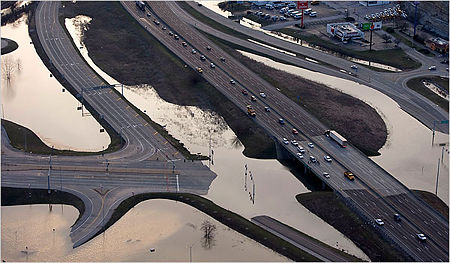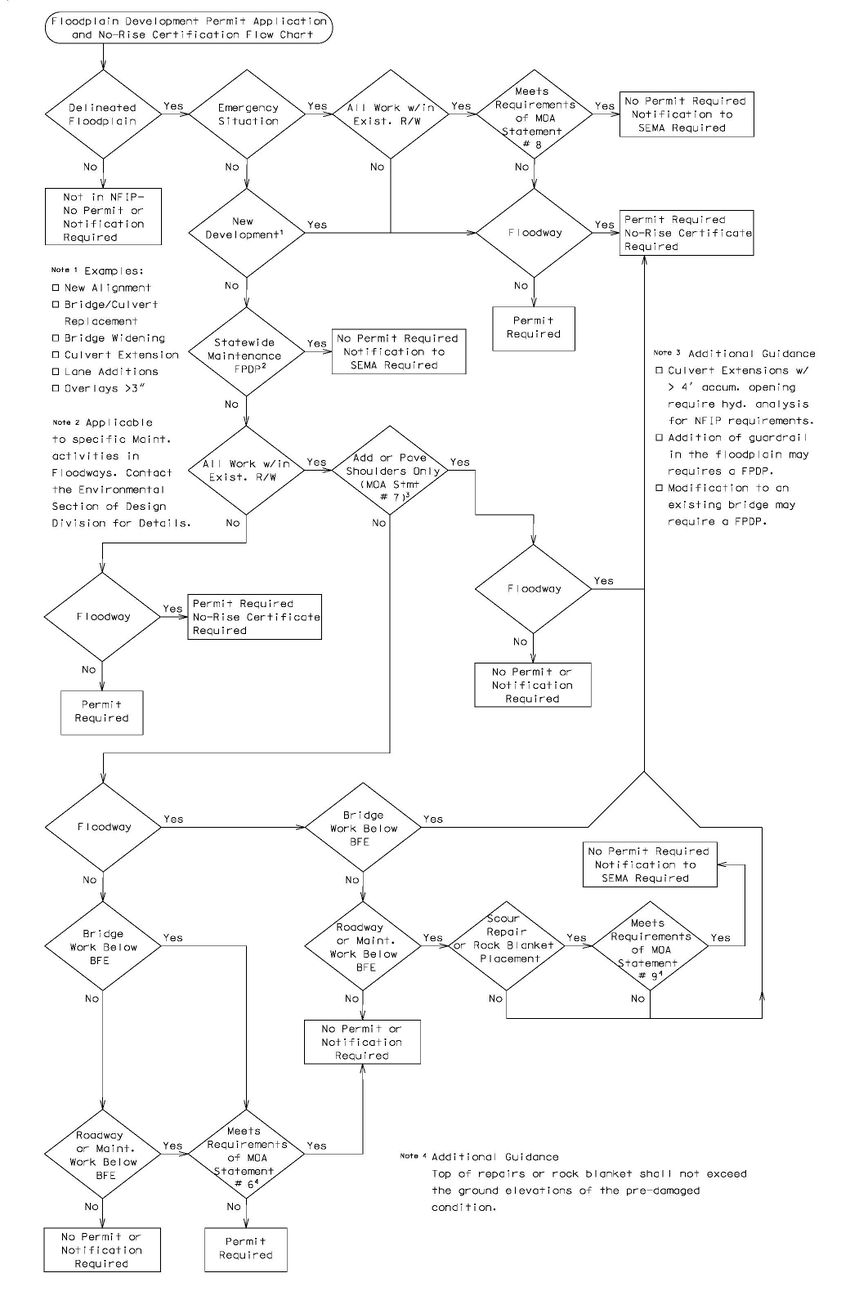127.9 Floodplain Management

127.9.1 National Flood Insurance Program (NFIP) Requirements
The Federal Highway Administration (FHWA), through 23 CFR 650A, requires the design of all floodplain encroachments be consistent with the standards established by FEMA for the NFIP.
FEMA (44 CFR 60.3) mandates that projects:
- within a special flood hazard area (base floodplain) can cause no more than a one-foot cumulative rise.
- within a regulatory floodway cannot increase Base Flood elevations.
- that do not meet the above criteria, require an approved conditional FIRM and a floodway revision (if applicable), as required by 44 CFR 65.12, before the project can be constructed.
For detailed information on meeting the requirements of the National Flood Insurance Program, see EPG 748.8 Development in Floodplains.
127.9.2 Laws and Regulations
- National Flood Insurance Act of 1968 (U.S. Code, title 42 – National Flood Insurance Program) provides flood insurance protection to property owners in flood-prone areas. Code of Federal Regulations title 44 (44 CFR Chapter 1 Subchapter B – Insurance and Hazard Mitigation) provides details and specifications of the National Flood Insurance Program.
- Executive Order 11988: Floodplain Management (DOT Order 5650.2, 23 CFR 771, 23 CFR 650, Subpart A) of 1977 seeks “to avoid to the extent possible the long and short-term adverse impacts associated with the occupation and modification of floodplains and to avoid direct and indirect support of floodplain development wherever there is a practicable alternative.”
- National Environmental Policy Act (NEPA) of 1969.
127.9.3 Floodplain Development Permits
127.9.3.1 Requirement Determination
Communities (cities, counties or states) participating in the National Flood Insurance Program (NFIP) are required to regulate construction in the floodplain. Communities accomplish this by requiring permits for development in special flood hazard areas. The State Emergency Management Agency (SEMA) has been granted authority (Executive Order No. 98-03) to regulate floodplain development by state agencies and to issue floodplain development permits for state projects. SEMA requires a floodplain development permit for any development in special flood hazard areas, regardless of whether the community is participating in the NFIP or not.
When a Floodplain Development Permit is required and part of a project is within a Regulatory Floodway, a “No-Rise” Certification must be provided with the Floodplain Development Permit Application. A “No-Rise” Certification is signed and sealed by an engineer licensed to practice in Missouri that a project will cause no rise in the regulatory floodway of a given flooding source. This confirms that the project will not create any increase to the Base Flood elevations on said flooding source at published cross-sections in the Flood Insurance Study for a given community and will not create any increase to the Base Flood elevations at unpublished cross-sections in the vicinity of the proposed development.
MoDOT has a Memorandum of Agreement (MOA) with SEMA to allow some construction and maintenance activities to be done without applying for a Floodplain Development Permit.
MoDOT also has Statewide Floodplain Development Permits with SEMA for specific maintenance activities in floodways.
Specifics of the project along with FEMA Floodplain Products, MoDOT’s MOA and Statewide Floodplain Development Permits with SEMA are used to determine if a Floodplain Development Permit is required and if “No-Rise” Certificate is required to be provided with the permit application. The following flow chart can be used to aid in this determination.

127.9.3.2 Process
The Design Division's Environmental Section reviews Request for Environmental Services (RES) at Project Development Milestones to determine whether there will be any encroachment into a floodplain, subject to NFIP requirements, and provides the results of these reviews to the district in the RES response.
Bridge Division and/or district Design in consultation with Design Division’s Environmental Section will be responsible for determining whether a floodplain development permit is required on the project, and for providing SEMA with any project information necessary to obtain the permit, including any required “No-Rise” certifications for work in a regulated floodway. Any required notifications to SEMA will be made by Environmental Section.
If the action will affect the base floodplain, as determined by 23 CFR 650.107, the environmental specialist will also include an evaluation and discussion in the NEPA document or RES as required under 23 CFR 650.111(e).
127.9.3.3 Responsibilities
If a permit is necessary, the Bridge Division will obtain the floodplain development permit(s) from SEMA for project elements that involve:
- construction of new numbered structures
- modifications to existing numbered structures below the Base Flood Elevation
- Roadway/maintenance structures/repairs where Bridge Division does a detailed hydraulic analysis.
The district will obtain the permit(s) for project elements that involve:
- un-numbered structures that are not included in a permit acquired by Bridge Division.
- roadway fill in a regulated floodplain that is not included in a permit acquired by Bridge Division.
- slope or scour repairs that do not involve numbered structures.
- slope or scour repairs at numbered structures, when no modifications to the existing structure are being made below the Base Flood Elevation.
Responsibility for situations that do not fit into one of the above categories will be determined on a case by case basis through consultation between the district and Bridge Division.
127.9.3.4 Completing a Floodplain Development Permit Application and “No-Rise” Certification
The SEMA and “No-Rise” Certification (when required) are to be completed with care, particularly:
- Property Owner shall be listed as: Missouri Highways and Transportation Commission; 105 West Capitol Avenue, Jefferson City, Missouri 65102.
- Community and County information should be provided for the actual location of the affected floodplain.
- Determination of the quarter-quarter section, township and range
- Type of Development: must include all aspects of the proposed construction, including grading, fill, and pavement in addition to proposed structures
- Information on premises, value of improvements, elevation of proposed development site and State of Missouri Ordinance Elevation are not required for roadway infrastructure
- Floodway/floodway fringe, Special Flood Hazard Area designation
- Base flood elevation and datum: the Flood Insurance Study’s Base Flood Elevation from the flood profile should be given if available
- Current map date
- Fields not filled with data should be marked N/A
The application for the permit shall include a FIRMette with the project location(s) noted.
127.9.4 Project Development Milestones
127.9.4.1 Location/Conceptual Plans Stage
When the district submits the Location/Conceptual Plans RES, the environmental specialist will identify whether the project is located in a 1% floodplain and/or the regulatory floodway. If the project will encroach upon the 1% floodplain and/or the regulatory floodway, the environmental specialist will communicate this to the district via the RES response.
127.9.4.2 Preliminary Plans Stage
When the district submits the Preliminary Plans RES, if floodplain impact was not previously evaluated, the environmental specialist will identify whether the project is located in a 1% floodplain and/or regulatory floodway. If the project will encroach upon the 1% floodplain and/or the regulatory floodway, the environmental specialist will communicate this to the district via the RES response.
127.9.4.3 Right of Way Plans Stage
When the district submits the Right of Way Plans RES, if floodplain impact was not previously evaluated, the environmental specialist will identify whether the project is located in a 1% floodplain and/or the regulatory floodway. If the project will encroach upon the 1% floodplain and/or the regulatory floodway, the environmental specialist will communicate this to the district via the RES response.
127.9.4.4 Final Design Plans Stage
When the district submits the Final Design Plans Stage RES, floodplain impact should have previously been evaluated and any required floodplain development permits should already be obtained. If floodplain impact was overlooked and has not been evaluated, or if there has been a change that may cause the project to encroach upon the 1% floodplain and/or regulatory floodway, the environmental specialist will identify whether the project is located in a 1% floodplain and/or regulatory floodway. However, the project may be delayed since any required floodplain development permit must be obtained prior to the letting.
127.9.4.5 Letting
Floodplain/Floodway impacts must be known prior to letting and any required floodplain development permits must have been obtained. The project may be delayed until these permits are received.